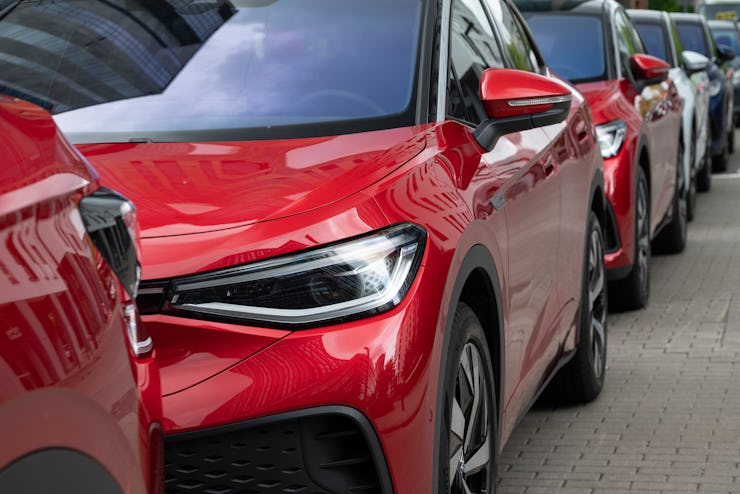Why U.S. Emissions Rules Are About To Make EVs a Lot More Popular
Stricter standards from the EPA mean more EV availbility for us.

The U.S. really wants to step on the gas when it comes to adopting electric vehicles. The Environmental Protection Agency just released new standards for car emissions, which could ensure that all-electric cars make up as much as two-thirds of new car sales in the U.S. by 2032.
Considering the new goalpost of 2035 is about seven years down the line, the U.S. is being far more ambitious in its push to convert entirely to EVs. It’s an even tighter timeframe than what the Biden administration originally laid out, which was to end ICE vehicle sales by 2035. That means the U.S. is getting serious about converting quickly to an all-electric lifestyle. Here’s what you need to know about the EPA’s new emissions standards.
WHAT ARE THE NEW EPA STANDARDS?
The EPA released its latest standards for all vehicle types that are model 2027 and beyond, which are designed to contribute to cleaner air and a greener future. The standards call for further reducing the amount of harmful air pollutant emissions, while also improving EV battery durability. Specifically, the EPA wants the industry to hit an average of 82 grams/mile of CO2 by model year 2032 for its light-duty vehicles, like passenger vehicles and small trucks. That average represents a 56 percent reduction in emissions compared to the existing model year 2026 standards.
With those standards, the EPA is also expecting EVs to make up 67 percent of car sales by model year 2032. It’s not exactly a deadline that the EPA is proposing, but rather these updated standards should result in EVs being a large majority of car sales by 2032.
WHAT ARE THE BENEFITS OF THESE NEW STANDARDS?
Most obviously, there will be fewer emissions caused by cars. The EPA says that the new standards would avoid up to nearly 10 billion tons of CO2 emissions by 2055. That should result in far fewer health complications that stem from polluted air. On a grand scale, it also allows the U.S. to rely less on oil imports, around 20 billion barrels less, according to the EPA.
The EPA also argues that the new standards would save the average consumer $12,000 over the lifetime of a passenger vehicle. That’s due to the standards calling for technological advancements that should reduce fuel and maintenance costs. Most importantly, we should get more EVs to choose from in the near future.
HOW DOES THIS AFFECT DRIVERS?
To line up with the new standards, we’ll likely see more EV development from car makers and in turn, more EV options on the market. We have a good amount of EV options to pick from the current market, but more options would only serve to benefit customers since carmakers would have to offer better technology or cheaper prices to stay competitive.
With an accelerated timeline of more EVs by 2032, that will likely mean the possibility of your next car being an EV could be a lot higher.
HOW DOES THIS AFFECT CARMAKERS?
The EPA’s updated standards put a lot more pressure on carmakers to ensure that most of their lineup is electric by 2032. Most carmakers have already voluntarily set their own goals of electrifying their entire lineup by at least 2035, like GM’s pledge to only sell EVs by 2035, or Volkswagen who says it will no longer sell ICE vehicles in Europe by 2035.
The carmakers who have willingly embraced the transition to EVs will likely be unaffected by the EPA’s standards. It’s the car companies who are behind with only one or two EV models released so far who may have to speed up their development process to catch up. As a side effect, the EPA’s new standards will cause a huge uptick in EV production, potentially exacerbating the current supply chain problems when it comes to making EV batteries.
HOW REALISTIC ARE THE EPA’S NEW STANDARDS?
Considering most carmakers are already committed to making only EVs going forward, the EPA’s new standards seem within reason. The only downside is there may be some casualties in automakers that are too slow to adapt to these new standards.
The other challenge is creating a decent enough EV charging infrastructure across the U.S. to the point where drivers don’t have to worry about range anxiety. The EPA does reference Biden’s investments in transitioning over to EVs, including supporting and developing more charging infrastructure. Drivers also now have the option to charge at Tesla’s Supercharger network even if you don’t drive a Tesla, thanks to a built-in adapter.
The EPA’s new standards feel appropriate for how fast the U.S.’ appetite for EVs seems to be growing. While ambitious, these new goalposts should help speed up the transition and drive up demand for EVs.